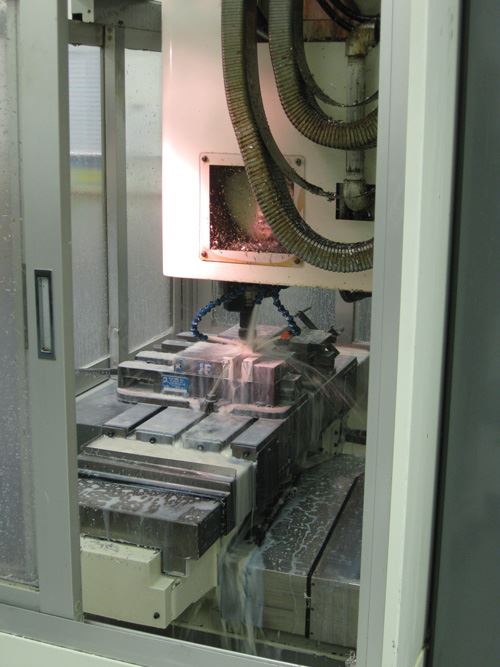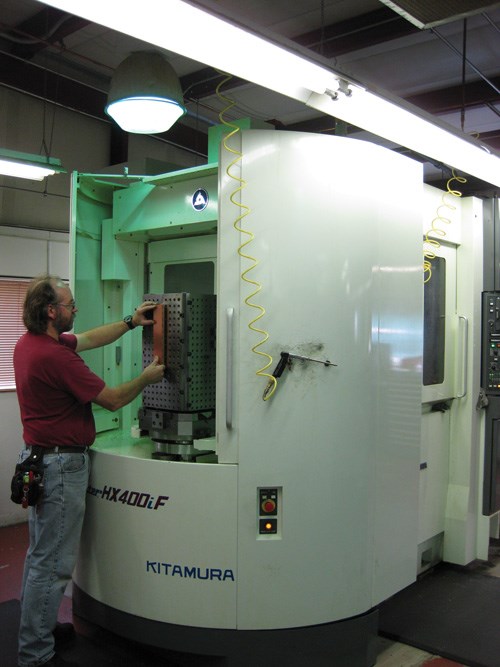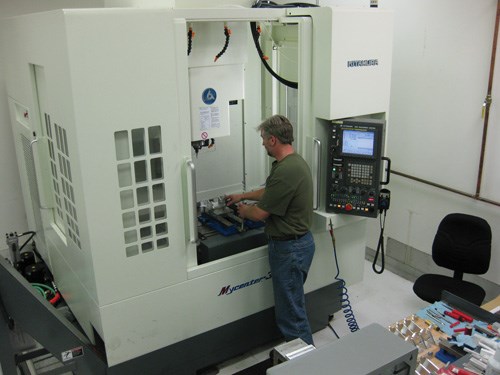HMC Reduces Setup Time On Low-Volume Jobs
Producing parts right the first time is especially important for a job shop that pays as much as $10,000 for raw material. Although complex geometries and tight delivery schedules initially made this challenging, a four-axis HMC with pallet changer allowed faster setups and unattended production.
"There are no service calls in space," says Bob Bergstrom, president of St. Vrain Manufacturing. This statement exemplifies the sense of urgency that accompanies St. Vrain’s drive to manufacture products with zero defects. That is a common goal among manufacturers, but it is even more important for this Longmont, Colorado job shop—parts machined here often wind up thousands or even millions of miles from Earth as components of orbiting satellites, space vehicles or even robots exploring the surface of Mars. Additionally, raw material can cost more than $10,000 per piece, so doing the job right the first time is critical.
Such parts are often highly complex, but that is only part of the challenge. Many of these complex parts require lengthy setup times, a problem exacerbated by the fact that often, only a handful of parts are produced. Low volumes present difficulties even when parts have simpler geometries because many are machined on an as-needed basis under a tight delivery deadline. Further complicating matters are the difficulties inherent in cutting materials such as titanium, Invar and hardened stainless steel used for many aerospace components. To address these difficulties, the company needed a machining center that could not only handle the challenging work it already had, but also help break into new areas to further grow the business. With Kitamura’s Mycenter-HX400iF HMC, the shop reduced setup times, maintained the required precision and rigidity for difficult parts and moved into unattended
production.
St. Vrain has been manufacturing aerospace industry parts since 1995. Its customers include Lockheed Martin, Coherent Technologies, the National Center for Atmospheric Research, ATK Aerospace and Starsys Corp. While most of the work performed at the 10,200-square-foot, climate-controlled facility is prototyping and short-run precision machining, the company also performs longer production runs.
One particular job, a cover for a large aerospace manufacturer, provides an example of the challenges at St. Vrain. Measuring 15 by 12 by 3.5 inches, the component has 0.04-inch-thick walls, a dome top and radiused ends with a flat back. It was machined in six operations, including 3D surfacing and helical interpolation of screw threads on the inside ports. Cut from a 127-pound piece of raw material, the finished part weighs just 1.5 pounds. "It took 200 hours to make two of these parts, most of which were programming and setup time," Mr. Bergstrom says. "This project was extreme, but it gives an idea of what we face on a daily basis."
As the difficulty of manufacturing such parts increased and customer lead times decreased, Mr. Bergstrom, operations manager David Lindsay and shop supervisor Tim Henker determined they needed an equipment upgrade. "When we looked closely at our business, we realized we needed versatility in addition to quality and productivity," Mr. Lindsay says. "We needed machines that would allow us to quickly move from aluminum on one job to roughing a titanium piece with a 2-inch cutter on the next—and we needed to do it without sacrificing accuracy."
Another key consideration in the decision was rigidity. Whether the machine would be used for high speed production or low-speed, high-torque applications, it would need a high degree of rigidity to satisfy the demands of the shop’s jobs. The tendency for vibration in the difficult-to-machine materials common at the shop meant the machine had to maintain true positions and tolerances as tight as 0.001 inch. It also needed the capability to cut very thin walls.
After comparing specifications and witnessing several machines in production, the team determined that Kitamura machines best met their strict criteria. Mr. Henker says these machines’ rigid, boxway construction and hand-scraped contact surfaces, which yield a better fit than machine-finishing, are indicative of their quality. "We actually looked at several brands of horizontal machines and did some test cuts with the types of material we use on a regular basis," he says. "The competitors’ machines made the cuts, but the whole machine and even the shop floor were vibrating. The Kitamura sounded like a good, healthy cut—it didn’t sound like you were abusing the machine."
Further investigation revealed that the machines were equally adept at both heavy-duty machining and high speed, high-production runs on lighter materials. Most models, on the other hand, could do "one or the other, but not both," Mr. Lindsay says. This versatility is enhanced by a geared head that is capable of 15,000 rpm on the high end and high torque at low rpm. Also, the high speed look-ahead features of the machines’ controls aid the shop in performing more efficient, accurate 3D surfacing work.
One factor in the shop’s decision was familiarity. Its first Kitamura, a 10-year-old Mycenter-2X vertical, still makes good parts every day, Mr. Henker says. This led the team to believe that newer models would perform equally well over time. In 2004, the company added a Mycenter-4Xi and a Mycenter-3XiF. The latest acquisition, the Mycenter-HX400iF, was chosen for a number of reasons, most notably its fourth axis and two-station, automatic pallet changer.
The shop wanted a true fourth axis, not just an indexer, Mr. Bergstrom says. This would allow producing hinge or clevis-type parts in a single setup. With a true, synchronized fourth axis as a standard feature, the Mycenter-HX400iF fit the bill. Additionally, the machine’s two-station, automatic pallet changer provides setup flexibility for various jobs, resulting in greater overall productivity. For example, operators can set up some of the shop’s low-volume jobs once, then run them again as needed. This capability both reduces setup times and minimizes time for work in progress, the company says. "On a lot of the jobs we run, we will set up the first and second operation on one tombstone and the third and fourth on a second," Mr. Henker says. "That way, we can get the complete parts in one full operation rather than having to start, stop, reset and start again."
The machine has also enabled the company to move into unattended manufacturing. Although the HMC runs 24 hours a day, it is attended for only 8. The shop says this has significantly improved productivity and allowed it to lower prices on certain jobs without sacrificing profitability. The company is now looking for more of that type of work.
"When we run parts on our Kitamura machines, we are confident that they will be manufactured to specifications the first time," Mr. Lindsay says. "That’s important on production runs and on jobs where you spend 100 hours or more to produce two parts at a time."
Related Content
How to Start a Swiss Machining Department From Scratch
When Shamrock Precision needed to cut production time of its bread-and-butter parts in half, it turned to a new type of machine tool and a new CAM system. Here’s how the company succeeded, despite the newness of it all.
Read MorePalmgren Launches Combination Bench Lathe, Mill
The 11" bench engine lathe and gear head mill is able to handle a wide range of turning, milling and drilling operations typically found on much larger machinery.
Read MoreBuying a Lathe: The Basics
Lathes represent some of the oldest machining technology, but it’s still helpful to remember the basics when considering the purchase of a new turning machine.
Read MoreUnderstanding Swiss-Type Machining
Once seen as a specialty machine tool, the CNC Swiss-type is increasingly being used in shops that are full of more conventional CNC machines. For the newcomer to Swiss-type machining, here is what the learning curve is like.
Read MoreRead Next
Obscure CNC Features That Can Help (or Hurt) You
You cannot begin to take advantage of an available feature if you do not know it exists. Conversely, you will not know how to avoid CNC features that may be detrimental to your process.
Read More3 Mistakes That Cause CNC Programs to Fail
Despite enhancements to manufacturing technology, there are still issues today that can cause programs to fail. These failures can cause lost time, scrapped parts, damaged machines and even injured operators.
Read MoreThe Cut Scene: The Finer Details of Large-Format Machining
Small details and features can have an outsized impact on large parts, such as Barbco’s collapsible utility drill head.
Read More























.png;maxWidth=300;quality=90)








